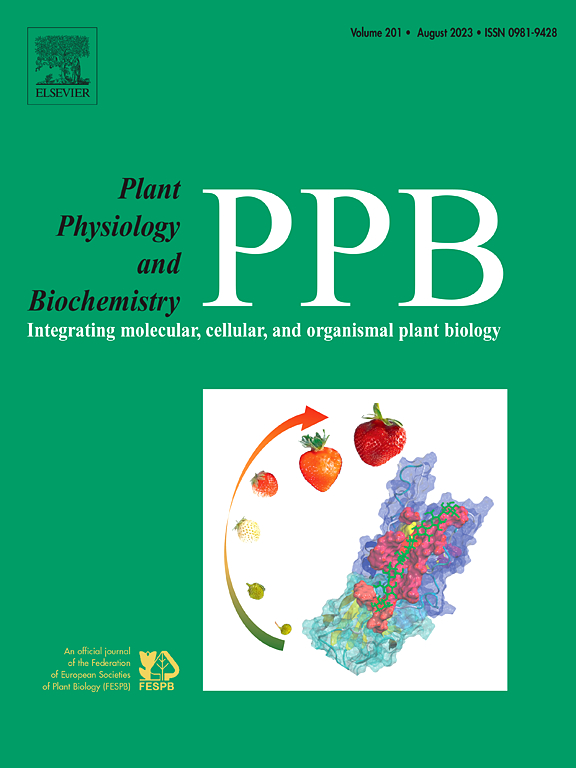Ectopic expression of strawberry FaMADS6 represses anthocyanin biosynthesis in both tobacco and Arabidopsis thaliana
IF 6.1
2区 生物学
Q1 PLANT SCIENCES
引用次数: 0
Abstract
Anthocyanins are important secondary metabolism phytochemicals that contribute to health, quality, and plant stress resistance. The class B MADS-box gene family is fundamental for floral organ development across different species. In this study, we reveal a novel function of the strawberry PISTILLATA homologue FaMADS6, in N. tabacum and Arabidopsis. FaMADS6 overexpression in tobacco affects floral organ development and seed set, leading to changes in pistil stigma, stamen petalisation and corolla morphology. Interestingly, these phenotypic alternations were not observed in transgenic Arabidopsis. We investigated the connection between FaMADS6 and anthocyanin accumulation. FaMADS6 expression levels in red- and white-petaled strawberries were negatively correlated with anthocyanin accumulation. Overexpression of FaMADS6 repressed anthocyanin production, as well as the transcript levels of structural genes and key R2R3 MYB-family transcription factors in transgenic tobacco petals and Arabidopsis seedlings. Additionally, Y1H, EMSA, and Dual-luc assays demonstrated that FaMADS6 regulated the transcription of NtAN2, AtMYB75, and AtMYB90 by directly binding to their promoter regions, leading to the repression of their expression. Furthermore, exogenous ABA at varying concentrations inhibited the promoter activity of FaMADS6, highlighting the role of ABA-mediated repression of FaMADS6 in regulating anthocyanin biosynthesis during strawberry fruit development. Therefore, as a B-functional gene, FaMADS6 is involved not only in determining the identity of floral organs but also in repressing anthocyanin biosynthesis. Overall, this study deepens our understanding of the multifunctional evolution of plant class B MADS-box genes and provides molecular insights that could contribute to improving strawberry quality.
草莓FaMADS6异位表达抑制烟草和拟南芥花青素的生物合成
花青素是一种重要的次生代谢植物化学物质,对植物的健康、品质和抗逆性有重要作用。B类MADS-box基因家族是不同物种花器官发育的基础。在这项研究中,我们揭示了草莓PISTILLATA同源基因FaMADS6在烟草和拟南芥中的新功能。FaMADS6在烟草中的过表达影响花器官发育和种子结实,导致雌蕊柱头、雄蕊花瓣和花冠形态的改变。有趣的是,在转基因拟南芥中没有观察到这些表型变化。我们研究了FaMADS6与花青素积累的关系。FaMADS6在红白花瓣草莓中的表达水平与花青素积累呈负相关。FaMADS6的过表达抑制了转基因烟草花瓣和拟南芥幼苗花青素的产生,以及结构基因和关键R2R3 myb家族转录因子的转录水平。此外,Y1H、EMSA和Dual-luc实验表明FaMADS6通过直接结合NtAN2、AtMYB75和AtMYB90的启动子区域调节其转录,从而抑制其表达。此外,不同浓度的外源ABA抑制了FaMADS6启动子的活性,突出了ABA介导的FaMADS6抑制在草莓果实发育过程中调节花青素生物合成的作用。因此,FaMADS6作为一个b功能基因,不仅参与决定花器官的身份,还参与抑制花青素的生物合成。总的来说,本研究加深了我们对植物B类MADS-box基因多功能进化的认识,并为提高草莓品质提供了分子见解。
本文章由计算机程序翻译,如有差异,请以英文原文为准。
求助全文
约1分钟内获得全文
求助全文
来源期刊
CiteScore
11.10
自引率
3.10%
发文量
410
审稿时长
33 days
期刊介绍:
Plant Physiology and Biochemistry publishes original theoretical, experimental and technical contributions in the various fields of plant physiology (biochemistry, physiology, structure, genetics, plant-microbe interactions, etc.) at diverse levels of integration (molecular, subcellular, cellular, organ, whole plant, environmental). Opinions expressed in the journal are the sole responsibility of the authors and publication does not imply the editors'' agreement.
Manuscripts describing molecular-genetic and/or gene expression data that are not integrated with biochemical analysis and/or actual measurements of plant physiological processes are not suitable for PPB. Also "Omics" studies (transcriptomics, proteomics, metabolomics, etc.) reporting descriptive analysis without an element of functional validation assays, will not be considered. Similarly, applied agronomic or phytochemical studies that generate no new, fundamental insights in plant physiological and/or biochemical processes are not suitable for publication in PPB.
Plant Physiology and Biochemistry publishes several types of articles: Reviews, Papers and Short Papers. Articles for Reviews are either invited by the editor or proposed by the authors for the editor''s prior agreement. Reviews should not exceed 40 typewritten pages and Short Papers no more than approximately 8 typewritten pages. The fundamental character of Plant Physiology and Biochemistry remains that of a journal for original results.

 求助内容:
求助内容: 应助结果提醒方式:
应助结果提醒方式:


